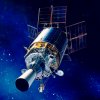| . |  |
. |
 Cape Canaveral - April 7, 1999 - The Boeing Inertial Upper Stage (IUS) carrying a Defense Support Program (DSP) satellite for the U.S. Air Force and Department of Defense will be launched aboard a Titan rocket from here this week.
Cape Canaveral - April 7, 1999 - The Boeing Inertial Upper Stage (IUS) carrying a Defense Support Program (DSP) satellite for the U.S. Air Force and Department of Defense will be launched aboard a Titan rocket from here this week.Lift-off is scheduled for 11:33 a.m. EDT April 9 from Space Launch Complex 41. Approximately nine minutes into flight, the IUS and its payload, a DSP satellite, will be deployed. DSP satellites are part of a national security system that helps protect the United States and its allies by detecting missile launches, space launches and nuclear detonations. Following separation from the Titan IV booster, and over the next six hours and 45 minutes, the IUS will fire its two stages -- the first for 142 seconds and the second stage for 110 seconds -- to propel the spacecraft toward its proper orbit. The IUS also will supply power to the spacecraft and perform "rotisserie-like" roll maneuvers to protect it from damage due to extreme heat or cold. The launch will be the first mission for the IUS using a new flight controller introduced as part of an effort to update the vehicle's avionics. The new hardware delivers higher reliability and greater accuracy, but weighs less and uses less power. "We're pleased to be able to offer this latest technology to our Air Force customer," said Paul Bay, Boeing IUS program manager. "The changes made to the IUS will ensure the vehicle will continue to serve our nation well into the next century." The IUS had its inaugural flight in 1982; since then it has delivered 17 payloads to a wide range of earth orbits and planetary trajectories. Compatible with both the Space Shuttle and the Titan IV rocket, the IUS is a two-stage payload delivery vehicle that delivers spacecraft into a wide range of Earth orbits beyond the launch vehicle's capability. The IUS can boost up to 5,000 pounds to geosynchronous orbit, and 8,000 pounds out of Earth's gravitational field, and features fully redundant avionics for guidance, navigation control and communications. Boeing assembles and tests the IUS for the U.S. Air Force and NASA at its Kent, Wash., facility, and is responsible for spacecraft integration and checkout, ground operations and launch preparation at Cape Canaveral, Fla., and launch and mission control operations.
DSP and Related Stories at SpaceDaily
|
| |||||||||
| The content herein, unless otherwise known to be public domain, are Copyright 1995-2016 - Space Media Network. All websites are published in Australia and are solely subject to Australian law and governed by Fair Use principals for news reporting and research purposes. AFP, UPI and IANS news wire stories are copyright Agence France-Presse, United Press International and Indo-Asia News Service. ESA news reports are copyright European Space Agency. All NASA sourced material is public domain. Additional copyrights may apply in whole or part to other bona fide parties. Advertising does not imply endorsement, agreement or approval of any opinions, statements or information provided by Space Media Network on any Web page published or hosted by Space Media Network. Privacy Statement All images and articles appearing on Space Media Network have been edited or digitally altered in some way. Any requests to remove copyright material will be acted upon in a timely and appropriate manner. Any attempt to extort money from Space Media Network will be ignored and reported to Australian Law Enforcement Agencies as a potential case of financial fraud involving the use of a telephonic carriage device or postal service. |